Underground military galleries
Underground military galleries
The concept of defense installations of Petrovaradin Fortress is adapted to the terrain and the elevated hillside of the Petrovaradin Rock that gradually, in the form of fortification rings, downs to its base. Unlike the Lower Fortress (Wasserstadt), which was fortified by ramparts and moats filled with the Danube water, Upper Fortress and extended part of the Fortress – Hornwerk, as inseparable parts of the Fortress complex, were fortified next to bastions and ramparts and so-called dry moats. These moats were formed as defensive zones between two rows of ramparts − escarpment and contra-escarpment: bastion, ravelin and contra-guard (earthen walled fortifications) in the function of barriers with trap into which was systematically inserted hostile living force, which was, after gunfire and cannonade treated by explosion from underground mine galleries.
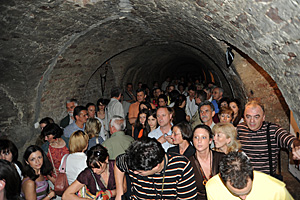
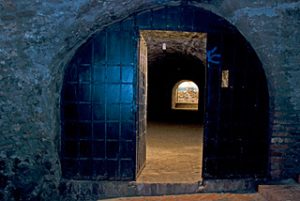
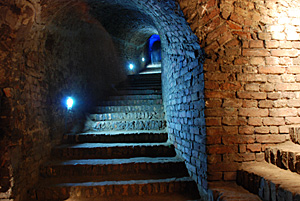
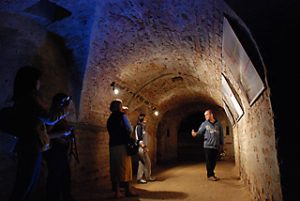

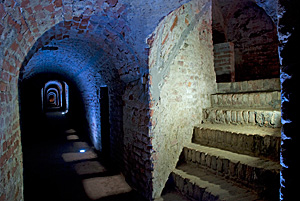
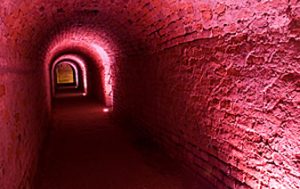
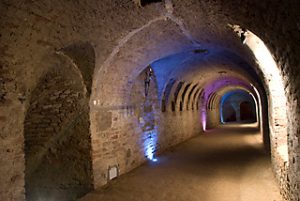
Defenders of the Fortress, members of the Petrovaradin regiment, were operating on the defensive position known as Borbena linija (the Battle Line), which architecturally continued into the system of underground mine galleries.
During the penetration of enemy soldiers in the moat, they were firstly attacked by small arms volleys from the upper battle line in earthen protective battlement – Bonet over the ramparts or bastion front.
First battle line formed within the escarpment and contra-escarpment of the rampart was constructed in the form of a long underground and vaulted passage, frontally set toward the moat. From here were also fired by small arms volleys, but also from the loopholes with vents for gunpowder gases, serially placed in the level of troops of enemy soldiers, who forcing the siege of the Fortress penetrate into the dry fortifications moats.
After the termination of the Fortress defenders’ operation, from the battle lines on battlements and within the ramparts and bastions, as well as from the large hole embrasure from which the artillery acted, the Fortress’ engineering started to burn the wicks into the underground mine fields, that are located below the ramparts, also serially placed in relation to the passages of the front line and contained barrels of gunpowder.
During organized, coordinated and directed detonation of multiple underground mine installations, the whole minefield ahead bastion battle line and below the moat, was rising into the air, eliminating and at the same time overwhelming large number of enemy soldiers crowded in the moat with the intention of forcing the walls of defended bastion.
For that time perfectly efficient defensive installation of underground mine system, i.e. field, is work of the engineering Major and Austrian nobleman Alfred Schroeder, as a project of the defense system of the entire complex. The underground mine system of Petrovaradin Fortress was built in the period from 1765 to 1783, as a part of 16 km long and in four underground levels staggered system of Underground military galleries. The underground mine system was one of the largest among European fortifications.
The Petrovaradin Fortress was built in the period from 1692 to 1780, with great effort of the whole Habsburg Empire involving huge financial resources and the great loss of life during hard work − corvee during its construction, with the aim that this mighty fortress protecting the boundaries of the Empire. On the other hand, there was well-known fact that the Ottoman army consisted of disciplined and fanatical warriors, whose military units could at any time threaten the Fortress and penetrate into its interior, including the underground military galleries. According to the facts of a great importance of this monumental defensive fortifications and the constant threat of the Turks, the whole system of fortifications of the Petrovaradin Fortress especially its underground part, was made up of a series of combat installations, which, among other things, are in the form of different obstacles, traps and barricades.
Inside the underground fortification system, right on the front line were placed defensive installations such as this obstacle, so-called barricade, whose function was to prevent or ultimately slow down the penetration of enemy soldiers, if they had already managed to break through the ramparts and in the onrush forced into the inner passage. Defenders of the Fortress in combat actions retreated behind the barricade, which was formed as an obstacle, and then approached the internal loopholes from which they acted laterally with volleys and behind the enemy’s back, causing the effect of complete surprise. The factual trap with effective neutralizing of the invading opponents with armed fire and mining storage space with gunpowder, created physical and technical barriers, and the general confusion in opponents’ invasion. The barricade stopped further penetration of hostile life force, and enabled defenders of the Fortress to consolidate their position.
Additional Info
City Museum of Novi Sad © 2025.


